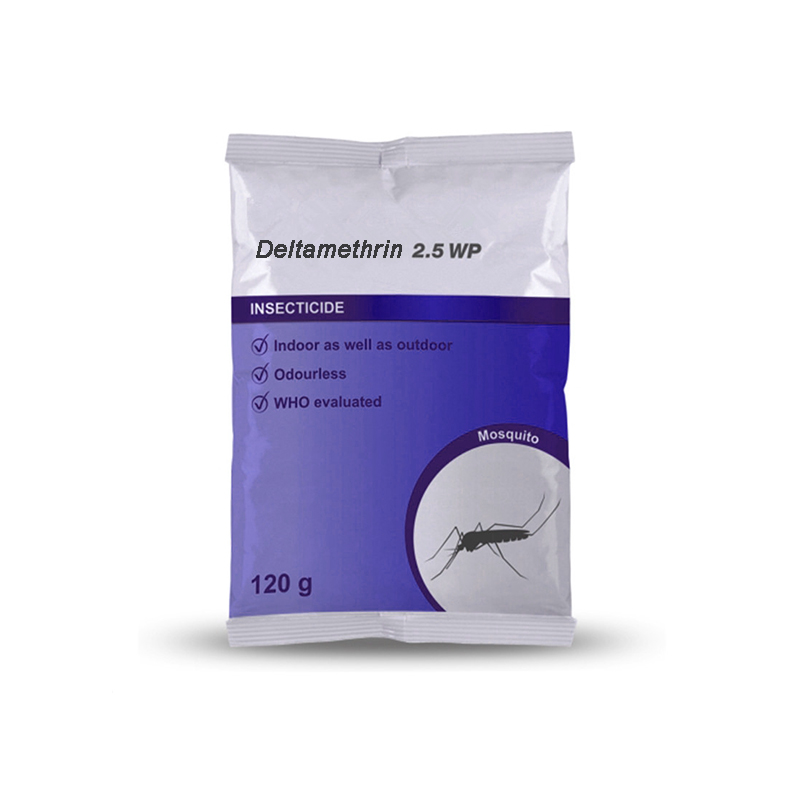Deltamethrin Deltamethrin Factory Price Insecticide Deltamethrin 98%TC CAS 52918-63-5
1.Introduction
Deltamethrin is one of the pyrethroid insecticides with the highest toxicity to insects. It has contact and stomach toxicity. It has rapid contact and strong knockdown force. It has no fumigation and internal absorption.
It can repel some pests at high concentration. The duration is long (7 ~ 12 days). Formulated into emulsifiable oil or wettable powder, it is a medium insecticide.
It has a wide range of insecticidal spectrum. It is effective for Lepidoptera, Orthoptera, tasyptera, Hemiptera, Diptera, Coleoptera and other pests, but it has little or basically no control effect on mites, scale insects and mirid elephants. It will also stimulate the reproduction of mites. When insects and mites are complicated, it should be mixed with special acaricides.
| Product name | Dealtamethrin |
| Other names | Decamethrin, decis, dealtametrin |
| Formulation and dosage | 2.5%EC, 5%EC, 2.5%WP, 5%WP |
| CAS No. | 52918-63-5 |
| Molecular formula | C22H19Br2NO3 |
| Type | Insecticide |
| Toxicity | Low toxic |
| Shelf life
|
2-3 years proper storage |
| sample | Free sample available |
| Mixed formulations | Lambda-cyhalothrin 1.5%+ amitraz 10.5% EC
Bifenthrin 2.5%+amitraz 12.5% EC Amitraz 10.6%+ abamectin 0.2% EC |
2.Application
2.1 To kill what pests?
It has a good killing effect on many pests such as cotton bollworm, red bollworm, cabbage worm, Plutella xylostella, Spodoptera litura, tobacco green worm, leaf eating beetle, aphid, blind toon, Toona sinensis, leaf cicada, heartworm, leaf miner, thorn moth, caterpillar, inchworm, bridge worm, armyworm, borer and locust.
2.2 To be used on what crops?
Deltamethrin is applicable to a wide range of crops, such as cruciferous vegetables, melon vegetables, legume vegetables, eggplant fruit vegetables, asparagus, rice, wheat, corn, sorghum, rape, peanut, soybean, sugar beet, sugarcane, flax, sunflower, alfalfa, cotton, tobacco, tea tree, apple, pear, peach, plum, jujube, persimmon, grape, chestnut, citrus, banana Litchi, duguo, trees, flowers, Chinese herbal medicine plants, grassland and other plants.
2.3 Dosage and usage
|
Formulations |
Crop names |
Control object |
Dosage |
Usage Method |
| 2.5%EC | Apple tree | Peach fruit borer | 1000-1500 times liquid | spray |
| Cruciferous vegetables | Cabbage worm | 450-750 ml/ha | spray | |
| cotton | aphid | 600-750 ml/ha | spray | |
| 5%EC | cabbage | Cabbage worm | 150-300 ml/ha | spray |
| Chinese cabbage | Cabbage worm | 300-450 ml/ha | spray | |
| 2.5%WP | Cruciferous vegetables | Cabbage worm | 450-600 g/ha | spray |
| sanitation | Mosquitoes, flies and cockroaches | 1 g/㎡ | Residual spraying | |
| sanitation | Begbugs | 1.2 g/㎡ | Residual spraying |
3.Notes
1. The control effect is better when the temperature is low, so it should avoid high temperature weather.
2. The spraying shall be uniform and considerate, especially for the control of drilling pests such as bean English borer and ginger borer. It shall be controlled in time before the larvae eat into the fruit pods or stems. Otherwise, the effect is low.
3. When using this kind of pesticides, the number and amount of drugs should be reduced as much as possible, or used alternately or mixed with non pyrethroid pesticides such as organophosphorus, which is conducive to slowing down the emergence of drug resistance of pests.
4. Do not mix with alkaline substances to avoid reducing the efficacy.
5. The drug has very low control effect on mite scale, so it can not be specially used as acaricide to avoid the rampant damage of mites. It is better not only to control cotton bollworm, aphid and other pests with rapid resistance development.
6. It is highly toxic to fish, shrimp, bees and silkworm. When using the drug, you should stay away from its feeding place to avoid serious loss.
7. The drug is forbidden 15 days before the harvest of leafy vegetables.
8. After poisoning by mistake, it shall be sent to the hospital for treatment immediately.
4.Packaging customized




